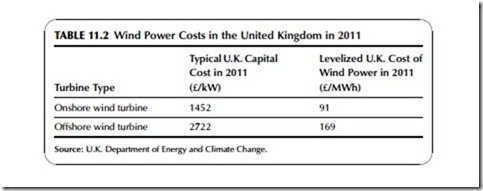COST OF WIND POWER
As with many renewable technologies, wind power is a capital-intensive form of power generation in which most of the investment over the life of the plant is required for its construction, while operational costs are relatively low and there are no fuel costs. The cost of wind turbines fell sharply during the 1990s and at the beginning of the 21st century as technology development and improved manufacturing techniques allowed economies to be made. Dur- ing the middle of the first decade of this century costs started to level out as the economies made by development were counterbalanced by some steep increases in commodity prices. This led to the prices for the installation of onshore wind generation starting to rise in the latter part of the decade. How- ever, the financial crisis at the end of the decade and the rapidly increasing competition in the wind turbine market led to costs starting to fall again as the second decade began.
The cost of building offshore wind farms is higher than the cost onshore. For U.K. waters the cost is probably close to 50% higher than for building onshore. Added to this, as offshore wind farms have moved into deeper waters farther from shore the cost of installation has risen, offsetting any gains from improvements in technology and installation techniques. Against this, offshore wind technology is at an earlier point in its development cycle than onshore wind technology, and there are likely to be further economic gains to be made in the cost of offshore technology, particularly for foundation construction. Float- ing wind turbine platforms and supports, in particular, could cut costs significantly if they can be perfected.
The U.K. Department of Energy and Climate (DECC) has estimated that the installed cost of onshore wind turbines in the United Kingdom in 2011 was £1452/kW. For offshore wind turbines, the installed cost in 2011 was estimated to be £2722/kW, as shown in Table 11.2. The U.K. DECC expects the cost of onshore wind turbines to fall only slightly over the next two decades. This view may be modified by the growing global competition between wind turbine manufacturers that could lead to capital costs falling more than had been expected. For offshore wind the U.K. DECC expected a significant fall in costs over the same period so that by 2030 the installed cost was predicted to be around 30% lower than in 2011. Competition for offshore wind turbines is not yet as fierce as for onshore machines but this could change, leading to steeper falls in price than this suggests.
The actual cost of electricity from a wind farm, as measured by the levelized cost, is also shown for U.K. wind farms in 2011. For large offshore wind farms (greater than 5 MW in capacity) the levelized cost was £91/MWh. Offshore wind, at £169/MWh, was significantly more expensive. In the United States, meanwhile, the U.S. Department of Energy found average wholesale wind energy costs for onshore wind capacity in 2012 to be $40/MWh based on new contracts for electricity from wind farms.
Based on these figures, electricity from wind power plants remains generally more expensive than power from the best conventional sources such as natural gas–fired combined cycle power plants, existing coal-fired power plants, and established hydropower plants. It is widely expected that this situation could change during this decade and that sometime toward the end of the decade wind power will achieve parity with these other sources. Whether this will happen will depend on a number of unpredictable factors including whether competition within the turbine market continues to lead to falling prices and the impact of shale gas in the United States and elsewhere.
